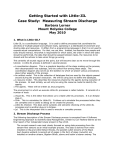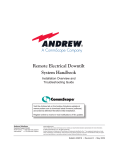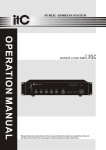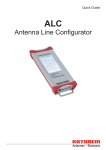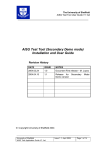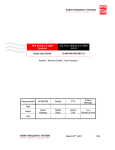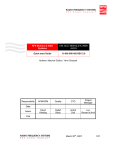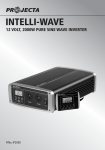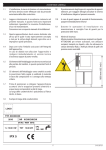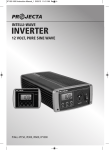Download RRU3008 User guide
Transcript
RRU3008 V300R008 User Guide Issue 03 Date 2009-04-20 Huawei Proprietary and Confidential Copyright © Huawei Technologies Co., Ltd. Huawei Technologies Co., Ltd. provides customers with comprehensive technical support and service. For any assistance, please contact our local office or company headquarters. Huawei Technologies Co., Ltd. Address: Huawei Industrial Base Bantian, Longgang Shenzhen 518129 People's Republic of China Website: http://www.huawei.com Email: [email protected] Copyright © Huawei Technologies Co., Ltd. 2009. All rights reserved. No part of this document may be reproduced or transmitted in any form or by any means without prior written consent of Huawei Technologies Co., Ltd. Trademarks and Permissions and other Huawei trademarks are the property of Huawei Technologies Co., Ltd. All other trademarks and trade names mentioned in this document are the property of their respective holders. Notice The information in this document is subject to change without notice. Every effort has been made in the preparation of this document to ensure accuracy of the contents, but the statements, information, and recommendations in this document do not constitute a warranty of any kind, express or implied. Huawei Proprietary and Confidential Copyright © Huawei Technologies Co., Ltd. RRU3008 User Guide Contents Contents About This Document.....................................................................................................................1 1 Changes in the RRU3008 User Guide.....................................................................................1-1 2 RRU3008 Hardware....................................................................................................................2-1 2.1 RRU3008 Equipment......................................................................................................................................2-2 2.1.1 Appearance of the RRU.........................................................................................................................2-2 2.1.2 Panels of the RRU Module.....................................................................................................................2-3 2.1.3 LEDs on the RRU3008..........................................................................................................................2-5 2.2 RRU3008 Cables.............................................................................................................................................2-7 2.2.1 RRU3008 Cable List..............................................................................................................................2-8 2.2.2 PGND Cable of the RRU.....................................................................................................................2-12 2.2.3 DC RRU Power Cable..........................................................................................................................2-13 2.2.4 AC Power Cable of the AC RRU.........................................................................................................2-13 2.2.5 DC Output Signal Cable of the AC RRU.............................................................................................2-16 2.2.6 CPRI Optical Cable..............................................................................................................................2-16 2.2.7 RRU RF Cable.....................................................................................................................................2-17 2.2.8 Alarm Cable of the DC RRU...............................................................................................................2-23 2.2.9 Signal Cable Between the CPRI Ports on the Cascaded RRUs...........................................................2-24 2.2.10 AISG Multi-Wire Cable of the RRU..................................................................................................2-24 2.2.11 AISG Extension Cable of the RRU....................................................................................................2-25 3 Maintaining the RRU3008........................................................................................................3-1 3.1 Maintenance Items of the RRU.......................................................................................................................3-2 3.2 Powering On and Powering Off the RRU.......................................................................................................3-2 3.2.1 Powering On the RRU............................................................................................................................3-2 3.2.2 Powering Off the RRU...........................................................................................................................3-3 3.3 Replacing an RRU3008...................................................................................................................................3-4 3.4 Replacing an Optical Module..........................................................................................................................3-8 4 Auxiliary Device of the RRU...................................................................................................4-1 4.1 AC Power Surge Protection Box.....................................................................................................................4-2 Issue 03 (2009-04-20) Huawei Proprietary and Confidential Copyright © Huawei Technologies Co., Ltd. i RRU3008 User Guide Figures Figures Figure 2-1 Appearance of the RRU3008..............................................................................................................2-3 Figure 2-2 AC RRU module................................................................................................................................2-3 Figure 2-3 Panels of the DC RRU module...........................................................................................................2-4 Figure 2-4 Panels of the AC RRU module...........................................................................................................2-4 Figure 2-5 PGND cable......................................................................................................................................2-12 Figure 2-6 DC RRU power cable.......................................................................................................................2-13 Figure 2-7 Power cable between the AC RRU and the AC surge protection box..............................................2-14 Figure 2-8 Power cable between the AC RRU and the external power equipment...........................................2-14 Figure 2-9 Power cable between the AC surge protection box and the external power equipment...................2-15 Figure 2-10 DC output signal cable of the AC RRU.........................................................................................2-16 Figure 2-11 CPRI optical cable..........................................................................................................................2-17 Figure 2-12 RF jumper.......................................................................................................................................2-18 Figure 2-13 Interconnect jumper........................................................................................................................2-18 Figure 2-14 Mapping between the RF cables and their colors...........................................................................2-19 Figure 2-15 RF cable connections (1)................................................................................................................2-19 Figure 2-16 RF cable connections (2)................................................................................................................2-20 Figure 2-17 RF cable connections (3)................................................................................................................2-21 Figure 2-18 RF cable connections (4)................................................................................................................2-22 Figure 2-19 RF cable connections of the RRU3008..........................................................................................2-23 Figure 2-20 Alarm cable.....................................................................................................................................2-23 Figure 2-21 Signal cable between the CPRI ports on cascaded RRUs .............................................................2-24 Figure 2-22 AISG multi-wire cable....................................................................................................................2-25 Figure 2-23 AISG extension cable.....................................................................................................................2-26 Figure 3-1 Removing the RRU3008....................................................................................................................3-5 Figure 3-2 Board Management window...............................................................................................................3-6 Figure 3-3 Checking whether the RRU runs normally.........................................................................................3-6 Figure 3-4 Querying the software version of the RRU3008................................................................................3-7 Figure 3-5 Checking whether the RRU3008 incurs alarms..................................................................................3-8 Figure 3-6 Checking whether the CPRI signal transmission is resumed...........................................................3-10 Figure 4-1 AC power surge protection box..........................................................................................................4-2 Issue 03 (2009-04-20) Huawei Proprietary and Confidential Copyright © Huawei Technologies Co., Ltd. iii RRU3008 User Guide Tables Tables Table 2-1 Ports, buttons, and LEDs on the panels of the RRU module...............................................................2-5 Table 2-2 LEDs on the RRU3008........................................................................................................................2-6 Table 2-3 Cable list...............................................................................................................................................2-8 Table 2-4 Pin assignment for the wires of the DC RRU power cable (North American standard)....................2-13 Table 2-5 Pin assignment for the wires of the DC RRU power cable (European standard)..............................2-13 Table 2-6 Pin assignment for the wires of the AC power cable between the AC RRU and the AC surge protection box and that for the AC RRU and the power equipment....................................................................................2-15 Table 2-7 Pin Assignment for the wires of the power cable between the AC surge protection box and the power supply device.......................................................................................................................................................2-16 Table 2-8 RF cable connections of the RRU3008 in different configurations...................................................2-19 Table 2-9 Pin assignment for the alarm cable....................................................................................................2-24 Table 2-10 Pin assignment for the AISG multi-wire cable................................................................................2-25 Table 2-11 Pin assignment for the AISG extension cable..................................................................................2-26 Table 3-1 Maintenance items associated with the RRU.......................................................................................3-2 Table 4-1 Specifications of the AC power surge protection box..........................................................................4-2 Table 4-2 Ports on the AC power surge protection box.......................................................................................4-3 Issue 03 (2009-04-20) Huawei Proprietary and Confidential Copyright © Huawei Technologies Co., Ltd. v RRU3008 User Guide About This Document About This Document Purpose This document provides a reference for you to plan and deploy the RRU3008. It describes the appearance, ports, and functions of the RRU3008, categories of the cables, and specifications and installation positions of the connectors. This document also provides methods for maintaining the RRU3008. Product Version The following table lists the product version related to this document. Product Name Product Version RRU3008 V300R008 Intended Audience This document is intended for: l RRU3008 installers l Technical support engineers l Maintenance engineers Organization 1 Changes in the RRU3008 User Guide This describes the changes in the RRU3008 User Guide. 2 RRU3008 Hardware This describes the functional modules, cables, and auxiliary equipment of the RRU3008. 3 Maintaining the RRU3008 This describes how to maintain the RRU3008. After the site is put into formal operation, you should perform routine maintenance on the RRU3008 to ensure that it runs properly. This document describes the maintenance items of the RRU3008, the power-on and power-off operations, and the method of replacing the RRU3008 modules and cables. 4 Auxiliary Device of the RRU Issue 03 (2009-04-20) Huawei Proprietary and Confidential Copyright © Huawei Technologies Co., Ltd. 1 RRU3008 User Guide About This Document The auxiliary device of the RRU refers to the AC power surge protection box used for the AC RRU in outdoor applications. Conventions Symbol Conventions The symbols that may be found in this document are defined as follows. Symbol Description Indicates a hazard with a high level of risk, which if not avoided,will result in death or serious injury. Indicates a hazard with a medium or low level of risk, which if not avoided, could result in minor or moderate injury. Indicates a potentially hazardous situation, which if not avoided,could result in equipment damage, data loss, performance degradation, or unexpected results. Indicates a tip that may help you solve a problem or save time. Provides additional information to emphasize or supplement important points of the main text. General Conventions The general conventions that may be found in this document are defined as follows. Convention Description Times New Roman Normal paragraphs are in Times New Roman. Boldface Names of files, directories, folders, and users are in boldface. For example, log in as user root. Italic Book titles are in italics. Courier New Examples of information displayed on the screen are in Courier New. Command Conventions The command conventions that may be found in this document are defined as follows. 2 Convention Description Boldface The keywords of a command line are in boldface. Italic Command arguments are in italics. Huawei Proprietary and Confidential Copyright © Huawei Technologies Co., Ltd. Issue 03 (2009-04-20) RRU3008 User Guide About This Document Convention Description [] Items (keywords or arguments) in brackets [ ] are optional. { x | y | ... } Optional items are grouped in braces and separated by vertical bars. One item is selected. [ x | y | ... ] Optional items are grouped in brackets and separated by vertical bars. One item is selected or no item is selected. { x | y | ... }* Optional items are grouped in braces and separated by vertical bars. A minimum of one item or a maximum of all items can be selected. [ x | y | ... ]* Optional items are grouped in brackets and separated by vertical bars. Several items or no item can be selected. GUI Conventions The GUI conventions that may be found in this document are defined as follows. Convention Description Boldface Buttons, menus, parameters, tabs, window, and dialog titles are in boldface. For example, click OK. > Multi-level menus are in boldface and separated by the ">" signs. For example, choose File > Create > Folder . Keyboard Operations The keyboard operations that may be found in this document are defined as follows. Format Description Key Press the key. For example, press Enter and press Tab. Key 1+Key 2 Press the keys concurrently. For example, pressing Ctrl+Alt +A means the three keys should be pressed concurrently. Key 1, Key 2 Press the keys in turn. For example, pressing Alt, A means the two keys should be pressed in turn. Mouse Operations The mouse operations that may be found in this document are defined as follows. Issue 03 (2009-04-20) Action Description Click Select and release the primary mouse button without moving the pointer. Huawei Proprietary and Confidential Copyright © Huawei Technologies Co., Ltd. 3 RRU3008 User Guide About This Document 4 Action Description Double-click Press the primary mouse button twice continuously and quickly without moving the pointer. Drag Press and hold the primary mouse button and move the pointer to a certain position. Huawei Proprietary and Confidential Copyright © Huawei Technologies Co., Ltd. Issue 03 (2009-04-20) RRU3008 User Guide 1 Changes in the RRU3008 User Guide 1 Changes in the RRU3008 User Guide This describes the changes in the RRU3008 User Guide. 03 (2009-04-20) This is the third commercial release. Compared with issue 02 (2009-01-20) of V300R008, no contents are added, deleted or revised. 02 (2009-01-20) This is the second commercial release. Compared with release 01 (2008-09-05) of V300R008, this release does not delete information but incorporates the following modifications: l The description of the list of RRU Cables is revised. For details, see 2.2.1 RRU3008 Cable List. l The description of the AC RRU power cable is added. For details, see 2.2.4 AC Power Cable of the AC RRU. l The description of the AC power surge protection box is added. For details, see 4.1 AC Power Surge Protection Box. 01 (2008-09-05) This is the initial trial release. Issue 03 (2009-04-20) Huawei Proprietary and Confidential Copyright © Huawei Technologies Co., Ltd. 1-1 RRU3008 User Guide 2 RRU3008 Hardware 2 RRU3008 Hardware About This Chapter This describes the functional modules, cables, and auxiliary equipment of the RRU3008. 2.1 RRU3008 Equipment The RRU3008 is an outdoor remote RF unit. It processes baseband signals and RF signals. 2.2 RRU3008 Cables The RRU3008 cables consist of the PGND cable, power cable, CPRI optical cable, RRU RF cable, alarm cable, signal cable between the CPRI ports on the cascaded RRUs, AISG multiwire cable, and AISG extension cable. Issue 03 (2009-04-20) Huawei Proprietary and Confidential Copyright © Huawei Technologies Co., Ltd. 2-1 RRU3008 User Guide 2 RRU3008 Hardware 2.1 RRU3008 Equipment The RRU3008 is an outdoor remote RF unit. It processes baseband signals and RF signals. The functions of the RRU3008 are as follows: l One RRU3008 module supports eight carriers. l Providing CPRI ports for communication with the BBU3900 l The frequency conversion technique is implemented in the transmit channel. The RRU3008 up-converts the baseband signals, performs digital-to-analog conversion, and then upconverts the IF signals to the GSM transmit frequency band. After filtered and amplified, the RF signals are sent to the antenna for transmission through the duplexer in the RF frontend unit. l Receives RF signals from the antenna and performs down-conversion, amplification, analog-to-digital conversion, digital down-conversion, matched filtering, and Automatic Gain Control (AGC), and then transmits the signals to the BBU3900 or macro BTS for further processing. l Power control and Voltage Standing Wave Ration (VSWR) detection l Enabling frequency synthesis l Generation and recovery of the clock circuitry at the CPRI interface, and the alarm detection 2.1.1 Appearance of the RRU The RRU3008 has a modular structure. The external ports of the RRU3008 are located at the bottom of the RRU3008 and in the cabling cavity. 2.1.2 Panels of the RRU Module The RRU module has a bottom panel, a cabling cavity panel, and an area attached with LEDs. 2.1.3 LEDs on the RRU3008 The RRU3008 has six LEDs that indicate its operating status. 2.1.1 Appearance of the RRU The RRU3008 has a modular structure. The external ports of the RRU3008 are located at the bottom of the RRU3008 and in the cabling cavity. Figure 2-1 shows the RRU3008. 2-2 Huawei Proprietary and Confidential Copyright © Huawei Technologies Co., Ltd. Issue 03 (2009-04-20) RRU3008 User Guide 2 RRU3008 Hardware Figure 2-1 Appearance of the RRU3008 Figure 2-2 shows the AC RRU module. Figure 2-2 AC RRU module 2.1.2 Panels of the RRU Module The RRU module has a bottom panel, a cabling cavity panel, and an area attached with LEDs. Figure 2-3 shows the panels of the DC RRU module. Issue 03 (2009-04-20) Huawei Proprietary and Confidential Copyright © Huawei Technologies Co., Ltd. 2-3 RRU3008 User Guide 2 RRU3008 Hardware Figure 2-3 Panels of the DC RRU module Figure 2-4 shows the panels of the AC RRU. Figure 2-4 Panels of the AC RRU module The DC RRU has the same LED panel and cabling cavity panel as the AC RRU. The bottom panels of the two RRUs are different. Table 2-1 describes the LEDs, cabling cavity panel, and bottom panel of the RRU. 2-4 Huawei Proprietary and Confidential Copyright © Huawei Technologies Co., Ltd. Issue 03 (2009-04-20) RRU3008 User Guide 2 RRU3008 Hardware Table 2-1 Ports, buttons, and LEDs on the panels of the RRU module Item Label Description (a) LED RUN Refer to 2.1.3 LEDs on the RRU3008. ALM VSWR TX_ACT CPRI_W CPRI_E (b) Cabling cavity panel (c) Bottom panel of the DC RRU (d) Bottom panel of the AC RRU RTN+ Power wiring post NEGTX RX CPRI_E Eastward optical/electrical port TX RX CPRI_W Westward optical/electrical port EXT_ALM Alarm port RST Hardware reset button VSWR Test button for VSWR alarms RX_IN/OUT RF interconnection port RET RET antenna port ANT_TX/RXA RF TX/RX port A ANT_TX/RXB RF TX/RX port B RX_IN/OUT Interconnection port for RF signals RET RET antenna communication port ANT_TX/RXA RF TX/RX port A ANT_TX/RXB RF TX/RX port B AC-in AC power supply socket - DC power supply socket 2.1.3 LEDs on the RRU3008 The RRU3008 has six LEDs that indicate its operating status. For the positions of the LEDs on the RRU3008, see 2.1.2 Panels of the RRU Module. Table 2-2 lists the LEDs on the RRU3008. Issue 03 (2009-04-20) Huawei Proprietary and Confidential Copyright © Huawei Technologies Co., Ltd. 2-5 RRU3008 User Guide 2 RRU3008 Hardware Table 2-2 LEDs on the RRU3008 Label Color Status Meaning RUN Green ON The board is faulty or undergoing version verification. OFF No power input is available. Blinking (ON for 1s and OFF for 1s) The board is operational. Blinking (ON for 0.25s and OFF for 0.25s) The software is being loaded. Blinking (ON for 0.25s and OFF for 0.25s) The alarms (excluding VSWR related alarms) are reported. OFF No alarms (excluding VSWR related alarms) are reported. ON The board is operational. OFF No power input is available. ON (red) The power amplifier is not operational. VSWR alarms reported from the ANT_TX/RX port are being held. Blinking (ON for 0.25s and OFF for 0.25s) (red) The power amplifier is operational. VSWR alarms are reported from the ANT_TX/RX port. OFF No VSWR alarms are reported. ON (green) The CPRI link is functional. ON (red) The reception of the optical module is abnormal and an alarm is generated. Blinking (ON for 0.25s and OFF for 0.25s) (red) The CPRI link has a loss-of-lock error. OFF The SFP is out-of-position or the optical module is powered off. ON (green) The CPRI link is functional. ON (red) The reception of the optical module is abnormal and an alarm is generated. ALM TX_ACT VSWR CPRI_W (westward CPRI LED) CPRI_E (eastward CPRI LED) 2-6 Red Green Red Red/green Red/green Huawei Proprietary and Confidential Copyright © Huawei Technologies Co., Ltd. Issue 03 (2009-04-20) RRU3008 User Guide 2 RRU3008 Hardware Label Color Status Meaning Blinking (ON for 0.25s and OFF for 0.25s) (red) The CPRI link has a loss-of-lock error. OFF The SFP is out-of-position or the optical module is powered off. 2.2 RRU3008 Cables The RRU3008 cables consist of the PGND cable, power cable, CPRI optical cable, RRU RF cable, alarm cable, signal cable between the CPRI ports on the cascaded RRUs, AISG multiwire cable, and AISG extension cable. 2.2.1 RRU3008 Cable List The RRU3008 cables are the PGND cable, power cable, CPRI optical cable, RF jumper, interconnect jumper, alarm cable, signal cable between the CPRI ports on the cascaded RRUs, AISG multi-wire cable, and AISG extension cable. 2.2.2 PGND Cable of the RRU The RRU PGND cable connects the RRU to the grounding bar to ensure the proper grounding of the RRU. When two RRUs are cascaded, you may connect one RRU to the external grounding and then equipotentially connect the two RRUs through the PGND cable. Alternatively, you may respectively connect the two RRUs to the grounding bar through external PGND cable. 2.2.3 DC RRU Power Cable The DC RRU power cable is used to lead the -48 V DC power from the external device and supply the working power to the DC RRU. 2.2.4 AC Power Cable of the AC RRU The AC power cable of the AC RRU feeds AC power from external equipment to the AC RRU. 2.2.5 DC Output Signal Cable of the AC RRU The DC output signal cable of the AC RRU feeds power to the AC RRU and monitors the running status of the RRU. 2.2.6 CPRI Optical Cable This describes the CPRI optical cable. The CPRI optical cable connects the BBU and the RRU, and transmits CPRI signals. The CPRI optical cable is classified into the single-mode optical cable and the multi-mode optical cable. The following describes the multi-mode optical cable. 2.2.7 RRU RF Cable The RRU RF cable consists of the RF jumper and the interconnect jumper. The RF jumper can be connected to the feeder or directly to the antenna. The interconnect jumper is used to connect the RX_IN/OUT ports of two RRUs so that RF signals can be transmitted between the two RRUs. 2.2.8 Alarm Cable of the DC RRU This describes the alarm cable of the DC RRU. The alarm cable of the DC RRU transmits alarm signals from the external equipment to the DC RRU, and monitors the external signals. 2.2.9 Signal Cable Between the CPRI Ports on the Cascaded RRUs The signal cable between the CPRI ports on cascaded RRUs transmits data and control signals sent by the BBU. Issue 03 (2009-04-20) Huawei Proprietary and Confidential Copyright © Huawei Technologies Co., Ltd. 2-7 RRU3008 User Guide 2 RRU3008 Hardware 2.2.10 AISG Multi-Wire Cable of the RRU This describes the AISG multi-wire cable of the RRU. The AISG multi-wire cable connects the RRU and RCU, and transmits the BTS signals for controlling the RET antenna. 2.2.11 AISG Extension Cable of the RRU This describes the AISG extension cable. If the distance between the RRU and the RCU exceeds 5 meters and the AISG multi-wire cable cannot cover the distance, you need to use the AISG extension cable to extend the AISG multi-wire cable. 2.2.1 RRU3008 Cable List The RRU3008 cables are the PGND cable, power cable, CPRI optical cable, RF jumper, interconnect jumper, alarm cable, signal cable between the CPRI ports on the cascaded RRUs, AISG multi-wire cable, and AISG extension cable. Table 2-3 lists the cables. Table 2-3 Cable list Cable Status Before Delivery Installation Position 2.2.2 PGND Cable of the RRU Neither end of the cable is connected before delivery. Therefore, the cable should be installed on site. l l l 2-8 Huawei Proprietary and Confidential Copyright © Huawei Technologies Co., Ltd. PGND cable between the AC RRU and the AC surge protection box – One end is connected to the grounding bolt at the bottom of one RRU. – The other end is connected to the grounding bolt at the side of the AC surge protection box. AC surge protection box PGND cable – One end is connected to the grounding bolt at the side of the AC surge protection box. – The other end is connected to the wiring terminal of the PGND bar. RRU PGND cable – One end is connected to the grounding bolt at the bottom of the RRU. – The other end is connected to the wiring terminal of the PGND bar. Issue 03 (2009-04-20) RRU3008 User Guide 2 RRU3008 Hardware Cable Status Before Delivery Installation Position 2.2.3 DC RRU Power Cable Neither end of the DC RRU power cable is connected before delivery. Therefore, the cable should be installed on site. One end is connected to the NEG(-) (for the blue wire) and RTN(+) (for the brown or black wire) wiring posts in the cabling cavity of the DC RRU. The other end is connected to the wiring post (20 A) on the external power device. Issue 03 (2009-04-20) Huawei Proprietary and Confidential Copyright © Huawei Technologies Co., Ltd. 2-9 RRU3008 User Guide 2 RRU3008 Hardware Cable Status Before Delivery 2.2.4 AC Power Cable of the AC RRU l Neither end of the power cable between the AC surge protection box and the AC RRU is connected before delivery. Therefore, the cable should be installed on site. l Neither end of the power cable between the AC RRU and the external power system is connected before delivery. Therefore, the cable should be installed on site. l Neither end of the power cable between the AC surge protection box and the external power system is connected before delivery. Therefore, the cable should be installed on site. Installation Position l l l 2-10 Huawei Proprietary and Confidential Copyright © Huawei Technologies Co., Ltd. Power cable between the AC RRU and the AC surge protection box – One end is connected to the AC-in port on the bottom panel of the AC RRU. – The other end is connected to the L/ L' (for the brown wire), N/N' (for the blue wire), and GND (for the green and yellow wire) terminals on the AC protection box. Power cable between the AC RRU and the external power system – One end is connected to the AC-in port on the bottom panel of the AC RRU. – The other end is connected to the external power system. Power cable between the AC surge protection box and the external power system – One end is connected to the L/L' (for the brown wire), N/N' (for the blue wire), and GND (for the green and yellow wire) terminals on the AC protection box. – The other end is connected to the external power system. Issue 03 (2009-04-20) RRU3008 User Guide 2 RRU3008 Hardware Cable Status Before Delivery Installation Position 2.2.5 DC Output Signal Cable of the AC RRU The cable is installed before delivery. One end is connected to the AC/DC power module of the AC RRU. The other end is connected to the NEG(-) (for the blue wire) and RTN(+) (for the brown wire) wiring posts and the EXT_ALM port in the cabling cavity of the AC RRU. 2.2.6 CPRI Optical Cable 2.2.7.1 RRU RF Jumper 2.2.7.2 Interconnect Jumper of the RRU 2.2.8 Alarm Cable of the DC RRU 2.2.9 Signal Cable Between the CPRI Ports on the Cascaded RRUs Issue 03 (2009-04-20) Neither end of the cable is connected before delivery. Therefore, the cable should be installed on site. One end is connected to the CPRI_W port in the cabling cavity of the RRU. Neither end of the cable is connected before delivery. Therefore, the cable should be installed on site. One end is connected to the ANT_TX/RX port at the bottom of the RRU. Neither end of the cable is connected before delivery. Therefore, the cable should be installed on site. One end is connected to the RX_IN/OUT port on one RRU. Neither end of the cable is connected before delivery. Therefore, the cable should be installed on site. One end is connected to the EXT_ALM port in the cabling cavity of the RRU. Neither end of the cable is connected before delivery. Therefore, the cable should be installed on site. One end is connected to the CPRI_E port in the cabling cavity of one RRU. The other end is connected to the CPRI_W port in the cabling cavity of the other RRU. Huawei Proprietary and Confidential Copyright © Huawei Technologies Co., Ltd. The other end is connected to the CPRI port on the BBU. The other end is connected to the antenna or feeder. The other end is connected to the RX_IN/OUT port on the other RRU. The other end is connected to the ports for alarm signals on the external device. 2-11 RRU3008 User Guide 2 RRU3008 Hardware Cable Status Before Delivery Installation Position 2.2.10 AISG Multi-Wire Cable of the RRU Neither end of the cable is connected before delivery. Therefore, the cable should be installed on site. One end is connected to the RET port at the bottom of the RRU. Neither end of the cable is connected before delivery. Therefore, the cable should be installed on site. One end is linked to the standard AISG female connector of the AISG multiwire cable. 2.2.11 AISG Extension Cable of the RRU The other end is connected to the corresponding port on the RCU or to the AISG extension cable. The other end is connected to the corresponding port on the RCU. 2.2.2 PGND Cable of the RRU The RRU PGND cable connects the RRU to the grounding bar to ensure the proper grounding of the RRU. When two RRUs are cascaded, you may connect one RRU to the external grounding and then equipotentially connect the two RRUs through the PGND cable. Alternatively, you may respectively connect the two RRUs to the grounding bar through external PGND cable. Appearance The cross-sectional area of the green and yellow PGND cable is 16 mm2. Both ends of the cable are OT terminals. The OT terminals need to be assembled on site. Figure 2-5 shows the PGND cable. Figure 2-5 PGND cable NOTE 2-12 l When an AC surge protection box is configured, the PGND cable is used to connect the AC surge protection box and the RRU so that the electric potential at the modules is equal. l When an AC surge protection box is configured, the PGND cable connects the AC surge protection box and the grounding bar to ensure the proper grounding of the AC surge protection box. l One end of the PGND cable that is connected to the RRU or AC surge protection box has M6 OT terminals, and the other end needs to be assembled with OT terminals of a proper size depending on the external ground bar on site. Huawei Proprietary and Confidential Copyright © Huawei Technologies Co., Ltd. Issue 03 (2009-04-20) RRU3008 User Guide 2 RRU3008 Hardware 2.2.3 DC RRU Power Cable The DC RRU power cable is used to lead the -48 V DC power from the external device and supply the working power to the DC RRU. Appearance The end that is connected to the DC RRU is two M4 OT terminals, and the other end needs to be added with OT terminals based on the external power device on site, as shown in Figure 2-6. Figure 2-6 DC RRU power cable Pin Assignment The DC RRU power cable is a 2-wire cable. Table 2-4 and Table 2-5 describe the pin assignment for the wires of the DC RRU power cable. Table 2-4 Pin assignment for the wires of the DC RRU power cable (North American standard) Wire Type Color NEG Blue RTN Black Table 2-5 Pin assignment for the wires of the DC RRU power cable (European standard) Wire Type Color NEG Blue RTN Brown 2.2.4 AC Power Cable of the AC RRU The AC power cable of the AC RRU feeds AC power from external equipment to the AC RRU. Appearance Figure 2-7 shows the power cable between the AC RRU and the AC surge protection box. Issue 03 (2009-04-20) Huawei Proprietary and Confidential Copyright © Huawei Technologies Co., Ltd. 2-13 RRU3008 User Guide 2 RRU3008 Hardware Figure 2-7 Power cable between the AC RRU and the AC surge protection box 2 View A C 1 H.S.Tube W B A X2 X4 A X1 X3 (1) 3-pin round connector (2) OT terminal Figure 2-8 shows the power cable between the AC RRU and the external power equipment when the AC surge protection box is not configured. Figure 2-8 Power cable between the AC RRU and the external power equipment View A C A 1 W B A 2 X1 (1) 3-pin round connector (2) Bare wire Figure 2-9 shows the power cable between the AC surge protection box and the external power equipment. 2-14 Huawei Proprietary and Confidential Copyright © Huawei Technologies Co., Ltd. Issue 03 (2009-04-20) RRU3008 User Guide 2 RRU3008 Hardware Figure 2-9 Power cable between the AC surge protection box and the external power equipment 1 H.S.Tude 2 X1 X2 X3 (1) OT terminal (2) Bare wire Pin Assignment Table 2-6 describes the pin assignment for the power cable between the AC RRU and the AC surge protection box and that between the AC RRU and the power equipment. Table 2-6 Pin assignment for the wires of the AC power cable between the AC RRU and the AC surge protection box and that for the AC RRU and the power equipment One End Color The Other End Connect ed to the AC Surge Protecti on Box The Other End Connect ed to the Power Equipm ent Description X1.A Brown X2 Bare wire L X1.B Blue X4 N X1.C Green and yellow X3 PE Table 2-7 describes the pin assignment for the wires of the power cable between the AC surge protection box and the power equipment. Issue 03 (2009-04-20) Huawei Proprietary and Confidential Copyright © Huawei Technologies Co., Ltd. 2-15 RRU3008 User Guide 2 RRU3008 Hardware Table 2-7 Pin Assignment for the wires of the power cable between the AC surge protection box and the power supply device One End The Other End Color Description X1 Bare wire Brown L X2 Blue N X3 Green and yellow PE 2.2.5 DC Output Signal Cable of the AC RRU The DC output signal cable of the AC RRU feeds power to the AC RRU and monitors the running status of the RRU. Appearance Figure 2-10 shows the DC output signal cable of the AC RRU. Figure 2-10 DC output signal cable of the AC RRU 1 2 (1) OT terminal H.S.Tube W (2) DB15 connector Cable Description The DC output signal cable of the AC RRU is connected before delivery. One end of the cable is connected to the AC/DC power module of the AC RRU, and the other end of the cable is connected to the RTN(+) and NEG(-) terminals and EXT_ALM port in the cabling cavity of the AC RRU. 2.2.6 CPRI Optical Cable This describes the CPRI optical cable. The CPRI optical cable connects the BBU and the RRU, and transmits CPRI signals. The CPRI optical cable is classified into the single-mode optical cable and the multi-mode optical cable. The following describes the multi-mode optical cable. 2-16 Huawei Proprietary and Confidential Copyright © Huawei Technologies Co., Ltd. Issue 03 (2009-04-20) RRU3008 User Guide 2 RRU3008 Hardware Appearance The CPRI optical cable is a multi-mode 2-wire cable with a DLC connectors at each end. Figure 2-11 shows the CPRI optical cable. Figure 2-11 CPRI optical cable Fiber tail label DLC connector Fiber tail 1A 2A 1B 2B Pin Assignment None. 2.2.7 RRU RF Cable The RRU RF cable consists of the RF jumper and the interconnect jumper. The RF jumper can be connected to the feeder or directly to the antenna. The interconnect jumper is used to connect the RX_IN/OUT ports of two RRUs so that RF signals can be transmitted between the two RRUs. 2.2.7.1 RRU RF Jumper The RF jumpers of the RRU are 1/2-inch jumpers. The RF jumper connects the ANT_TX/RX port at the bottom of the RRU module to the feeder or antenna. It transfers the input and output RF signals, thus facilitating the signal exchange between the NodeB and the antenna system. 2.2.7.2 Interconnect Jumper of the RRU This describes the interconnect jumper of the RRU. The interconnect jumper of the RRU connects the RX_IN/OUT ports of two RRUs, and transmits the RF signals between the RRUs in the same cell. 2.2.7.3 RF Cable Connections of the RRU3008 You can determine the appropriate RF cable connections based on the actual networking mode. RRU RF Jumper The RF jumpers of the RRU are 1/2-inch jumpers. The RF jumper connects the ANT_TX/RX port at the bottom of the RRU module to the feeder or antenna. It transfers the input and output RF signals, thus facilitating the signal exchange between the NodeB and the antenna system. Appearance The RF jumper has a DIN male connector at one end and a connector made based on field requirements at the other end. Figure 2-12 shows an example of the RF jumper where both ends are DIN male connectors. Issue 03 (2009-04-20) Huawei Proprietary and Confidential Copyright © Huawei Technologies Co., Ltd. 2-17 RRU3008 User Guide 2 RRU3008 Hardware Figure 2-12 RF jumper DIN male connector DIN male connector Pin Assignment None. Interconnect Jumper of the RRU This describes the interconnect jumper of the RRU. The interconnect jumper of the RRU connects the RX_IN/OUT ports of two RRUs, and transmits the RF signals between the RRUs in the same cell. Appearance Both ends of the interconnect jumper are DB2W2 connectors. Figure 2-13 shows the interconnect jumper. Figure 2-13 Interconnect jumper Pin Assignment None. RF Cable Connections of the RRU3008 You can determine the appropriate RF cable connections based on the actual networking mode. Table 2-8 describes the RF cable connections in different networking modes. NOTE Table 2-8 takes the star topology between the BBU3900 and the RRU3008 as an example. The RF cables differ from each other in colors. Figure 2-14 shows the mapping between the RF signal cables and their colors. 2-18 Huawei Proprietary and Confidential Copyright © Huawei Technologies Co., Ltd. Issue 03 (2009-04-20) RRU3008 User Guide 2 RRU3008 Hardware Figure 2-14 Mapping between the RF cables and their colors Feeder jumper CPRI optical cable CPRI signal cable for cascaded RRU modules RF jumper of cascaded RRU modules Table 2-8 RF cable connections of the RRU3008 in different configurations Typical Configur ation Hardware Configuration S1-S8 l One RRU3008 module l One dual-polarized antenna Figure 2-15 shows the related RF cable connections. Figure 2-15 RF cable connections (1) Software Configuration The settings of TRX attributes and antenna mode on the BSC side are as follows: l Transmit mode: No Combining l Receive mode: Main Diversity l Antenna mode: Double Feeder (2TX + 2RX) ANT Antenna ANT_TX/RXA ANT_TX/RXB RX_IN/OUT CPRI_W CPRI_E CPRI0 ~ CPRI5 BBU Issue 03 (2009-04-20) Huawei Proprietary and Confidential Copyright © Huawei Technologies Co., Ltd. 2-19 RRU3008 User Guide 2 RRU3008 Hardware Typical Configur ation Hardware Configuration S1-S4 l One RRU3008 module l One dual-polarized antenna Figure 2-16 shows the related RF cable connections. Figure 2-16 RF cable connections (2) Software Configuration The settings of TRX attributes and antenna mode on the BSC side are as follows: l Transmit mode: Transmit Diversity l Receive mode: Main Diversity l Antenna mode: Double Feeder (2TX + 2RX) ANT Antenna ANT_TX/RXA ANT_TX/RXB RX_IN/OUT CPRI_W CPRI_E CPRI0 ~ CPRI5 BBU 2-20 Huawei Proprietary and Confidential Copyright © Huawei Technologies Co., Ltd. Issue 03 (2009-04-20) RRU3008 User Guide 2 RRU3008 Hardware Typical Configur ation Hardware Configuration S5-S16 l Two RRU3008 modules l Two dual-polarized antennas Figure 2-17 shows the related RF cable connections. Figure 2-17 RF cable connections (3) Issue 03 (2009-04-20) Huawei Proprietary and Confidential Copyright © Huawei Technologies Co., Ltd. Software Configuration The settings of TRX attributes and antenna mode on the BSC side are as follows: l Transmit mode: No Combining l Receive mode: Main Diversity l Antenna mode: Double Feeder (2TX + 2RX) 2-21 RRU3008 User Guide 2 RRU3008 Hardware Typical Configur ation Hardware Configuration S5-S16 l Two RRU3008 modules l One dual-polarized antenna Figure 2-18 shows the related RF cable connections. Software Configuration The settings of TRX attributes and antenna mode on the BSC side are as follows: l Transmit mode: Combining l Receive mode: Main Diversity l Antenna mode: Single Feeder (1TX + 2RX) Figure 2-18 RF cable connections (4) The other available antenna modes for the RRU3008 are Single Feeder (1TX + 1RX), Double Feeder (1TX + 1RX), and Double Feeder (1TX + 2RX). Figure 2-19 shows cable connections. 2-22 Huawei Proprietary and Confidential Copyright © Huawei Technologies Co., Ltd. Issue 03 (2009-04-20) RRU3008 User Guide 2 RRU3008 Hardware Figure 2-19 RF cable connections of the RRU3008 TX/RX ANT_TX/RXA TX ANT_TX/RXB ANT_TX/RXA RX TX/RX RX ANT_TX/RXB ANT_TX/RXA ANT_TX/RXB RX_IN/OUT RX_IN/OUT RX_IN /OUT CPRI_W CPRI_W CPRI_W CPRI_E CPRI_E CPRI_E CPRI0 ~ CPRI5 CPRI0 BBU Single Feeder (1TX + 1RX) ~ CPRI5 BBU Double Feeder (1TX + 1RX) CPRI0 ~ CPRI5 BBU Double Feeder (1TX + 2RX) 2.2.8 Alarm Cable of the DC RRU This describes the alarm cable of the DC RRU. The alarm cable of the DC RRU transmits alarm signals from the external equipment to the DC RRU, and monitors the external signals. Appearance One end of the alarm cable is a DB15 connector, and the other end is eight cord end terminals. Figure 2-20 shows the alarm cable. Figure 2-20 Alarm cable Pin Assignment Table 2-9 describes the pin assignment for the alarm cable. Issue 03 (2009-04-20) Huawei Proprietary and Confidential Copyright © Huawei Technologies Co., Ltd. 2-23 RRU3008 User Guide 2 RRU3008 Hardware Table 2-9 Pin assignment for the alarm cable Pin of the DB15 Connector Signal name of DB15 connector Wire Color Wire Type Cord End Terminal Label X1.2 SWITCH_IN PUTO+ White and blue Twisted pair X2 SWITCH_I NPUT0+ X1.3 GND Blue X3 GND X1.6 SWITCH_IN PUT1+ White and orange X4 SWITCH_I NPUT1+ X1.7 GND Orange X5 GND X1.10 RS485_TX- White and Green X6 APM RX- X1.11 RS485_TX+ Green X7 APM RX+ X1.13 RS485_RX- White and Brown X8 APM TX- X1.14 RS485_RX+ Brown X9 APM TX+ Twisted pair Twisted pair Twisted pair 2.2.9 Signal Cable Between the CPRI Ports on the Cascaded RRUs The signal cable between the CPRI ports on cascaded RRUs transmits data and control signals sent by the BBU. Appearance The signal cable between the CPRI ports on cascaded RRUs is an SFP high-speed cable (2 m) or an optical cable. Figure 2-21 shows the SFP high-speed cable. Figure 2-21 Signal cable between the CPRI ports on cascaded RRUs P1 P10 P11 P20 P10 P1 B A Pin Assignment None. 2.2.10 AISG Multi-Wire Cable of the RRU This describes the AISG multi-wire cable of the RRU. The AISG multi-wire cable connects the RRU and RCU, and transmits the BTS signals for controlling the RET antenna. 2-24 Huawei Proprietary and Confidential Copyright © Huawei Technologies Co., Ltd. Issue 03 (2009-04-20) RRU3008 User Guide 2 RRU3008 Hardware NOTE The Remote Control Unit (RCU) is the driving motor of the phase shifter inside the RET antenna. The RCU runs the control commands received from the BTS to drive the stepper motor. The adjustable phase shifter inside the antenna is driven by the actuator so that the tilt of the antenna can be adjusted. Appearance One end of the AISG multi-wire cable is a DB9 waterproof connector and the other end is a standard AISG female connector, as shown in Figure 2-22. Figure 2-22 AISG multi-wire cable Pin Assignment Table 2-10 describes the pin assignment for the AISG multi-wire cable. Table 2-10 Pin assignment for the AISG multi-wire cable X1 End (Pin of the DB9 Waterproof Connector) Wire Type X2 End (Pin of the Standard AISG Female Connector) Core Description X1.1 Twisted pair X2.1 +12 V X1.7 Twisted pair X2.7 DC-GND X1.9 X1.3 X1.5 AISG_Switch Twisted pair X2.3 RS485 - X2.5 RS485 + 2.2.11 AISG Extension Cable of the RRU This describes the AISG extension cable. If the distance between the RRU and the RCU exceeds 5 meters and the AISG multi-wire cable cannot cover the distance, you need to use the AISG extension cable to extend the AISG multi-wire cable. Issue 03 (2009-04-20) Huawei Proprietary and Confidential Copyright © Huawei Technologies Co., Ltd. 2-25 RRU3008 User Guide 2 RRU3008 Hardware Appearance One end of the AISG extension cable is a standard AISG male connector and the other end is a standard AISG female connector, as shown in Figure 2-23. Figure 2-23 AISG extension cable Pin Assignment Table 2-11 describes the pin assignment for the AISG extension cable. Table 2-11 Pin assignment for the AISG extension cable X1 End (Pin of the Standard AISG Male Connector) Wire Type X2 End (Pin of the Standard AISG Female Connector) Color Core Description X1.1 Twisted pair X2.1 White and blue +12 V Blue X1.7 Twisted pair X2.7 White and orange DC Return A Orange X1.3 Twisted pair X1.5 X1.6 Twisted pair X2.3 White and green RS485 B X2.5 Green RS485 A X2.6 White and brown +24 V Brown 2-26 Huawei Proprietary and Confidential Copyright © Huawei Technologies Co., Ltd. Issue 03 (2009-04-20) RRU3008 User Guide 3 Maintaining the RRU3008 3 Maintaining the RRU3008 About This Chapter This describes how to maintain the RRU3008. After the site is put into formal operation, you should perform routine maintenance on the RRU3008 to ensure that it runs properly. This document describes the maintenance items of the RRU3008, the power-on and power-off operations, and the method of replacing the RRU3008 modules and cables. 3.1 Maintenance Items of the RRU This describes the maintenance items associated with the RRU. These maintenance items involve the checking of the equipment surface, equipment cleanness, and LEDs. 3.2 Powering On and Powering Off the RRU This describes how to power on and power off the RRU. When powering on the RRU, you should check the power supply voltage of the RRU and the status of the LEDs on the RRU. When powering off the RRU, you can perform normal power-off or emergency power-off operation based on field requirements. 3.3 Replacing an RRU3008 This describes how to replace an RRU. The RRU, a remote radio unit, forms a distributed NodeB system with the BBU. Replacing an RRU disrupts all the services carried by the RRU. In this case, an alarm is reported. 3.4 Replacing an Optical Module This describes how to replace the optical module. The optical module provides the electricaloptical interface for the optical transmission between the RRU and other devices. During the replacement of the optical module, the optical cable is removed. Thus, the CPRI signal transmission is disrupted. Issue 03 (2009-04-20) Huawei Proprietary and Confidential Copyright © Huawei Technologies Co., Ltd. 3-1 RRU3008 User Guide 3 Maintaining the RRU3008 3.1 Maintenance Items of the RRU This describes the maintenance items associated with the RRU. These maintenance items involve the checking of the equipment surface, equipment cleanness, and LEDs. Table 3-1 lists the maintenance items associated with the RRU. Table 3-1 Maintenance items associated with the RRU Item Period Operation Guide Reference Checking the equipment surface Monthly or quarterly Check whether there are dents, cracks, holes, or corrosion on the surface of the equipment and whether the cabinet label is legible. None. Checking the equipment cleanness Monthly or quarterly Check whether the equipment is clean. The surface of the equipment is clean. Checking the LEDs Monthly or quarterly Check whether the equipment operates normally by observing the LEDs on the equipment. For details about the status of the LEDs, refer to 2.1.3 LEDs on the RRU3008. 3.2 Powering On and Powering Off the RRU This describes how to power on and power off the RRU. When powering on the RRU, you should check the power supply voltage of the RRU and the status of the LEDs on the RRU. When powering off the RRU, you can perform normal power-off or emergency power-off operation based on field requirements. 3.2.1 Powering On the RRU This describes how to power on the RRU and check the RRU status. You should set the corresponding MCB on the auxiliary power device for the RRU to ON and then determine the operating status of the RRU based on the LED status. 3.2.2 Powering Off the RRU This describes how to power off the RRU and check the RRU status. The RRU power-off is classified into normal power-off and emergency power-off. 3.2.1 Powering On the RRU This describes how to power on the RRU and check the RRU status. You should set the corresponding MCB on the auxiliary power device for the RRU to ON and then determine the operating status of the RRU based on the LED status. Prerequisite l 3-2 The equipment and cables of the RRU are installed. Huawei Proprietary and Confidential Copyright © Huawei Technologies Co., Ltd. Issue 03 (2009-04-20) RRU3008 User Guide 3 Maintaining the RRU3008 l The input voltage of the DC RRU is within the range of -36 V DC to -57 V DC. l The input voltage of the AC RRU is within the range of 90 V AC to 290 V AC. Context CAUTION When the RRU is unpacked, it must be powered on within 24 hours. Each time the RRU is maintained after being put into use, the power-off duration cannot exceed 24 hours. Procedure Step 1 Power on the RRU. DANGER Do not look into the optical module after the RRU is powered on. Step 2 Wait 3 to 5 minutes, and then check the status of the LEDs on the RRU. For the meaning of the LED status, see 2.1.3 LEDs on the RRU3008. NOTE If RRU modules are cascaded, check the status of the LEDs on each of the RRU modules. Step 3 Take corresponding actions based on the LED status. If... Then... The RRU runs properly End the power-on task. The RRU is faulty Rectify the fault, and then go to Step 1. ----End 3.2.2 Powering Off the RRU This describes how to power off the RRU and check the RRU status. The RRU power-off is classified into normal power-off and emergency power-off. Procedure Step 1 Choose normal power-off or emergency power-off based on different situations. Issue 03 (2009-04-20) If... Then... The RRU needs to be powered off in the case of an equipment swap or a foreseeable regional blackout Go to Step 2 to perform the normal poweroff. Huawei Proprietary and Confidential Copyright © Huawei Technologies Co., Ltd. 3-3 RRU3008 User Guide 3 Maintaining the RRU3008 If... Then... An emergency such as an electric spark, smoke, or water immersion occurs in the RRU Go to Step 3 to perform the emergency power-off. Step 2 Set the corresponding MCB on the auxiliary power device for the RRU to OFF. NOTE If RRU modules are cascaded, take the impact on the lower-level RRU module into consideration when you power off an RRU module, so as to avoid disrupting ongoing services. Step 3 Cut off the external input power of the auxiliary power device for the RRU. If time permits, set the corresponding MCB on the device to OFF. ----End 3.3 Replacing an RRU3008 This describes how to replace an RRU. The RRU, a remote radio unit, forms a distributed NodeB system with the BBU. Replacing an RRU disrupts all the services carried by the RRU. In this case, an alarm is reported. Prerequisite l The number of the RRU3008s to be replaced is determined, and the new RRU3008 are available. l The installation positions of the RRU3008s are recorded. l The mapping between each cable and the port on the RRU3008 is recorded. l The user service tool kit is ready. Context CAUTION You must take proper ESD prevention measures, for example, wear an ESD wrist strap or a pair of ESD gloves to prevent the boards, modules, or electrical components from being damaged by static electricity generated by your body. Procedure Step 1 Power off the RRU. Step 2 Remove the cover plate from the cabling cavity of the RRU3008. Step 3 Remove all the cables that are connected to the RRU3008 and take proper insulation measures. Step 4 Loosen the captive screws of the two fixers on the main fixture. Then, fix the two screws on the RRU attachment plate. Removing a DC RRU is the same as removing an AC RRU. Figure 3-1 takes removing a DC RRU as an example. 3-4 Huawei Proprietary and Confidential Copyright © Huawei Technologies Co., Ltd. Issue 03 (2009-04-20) RRU3008 User Guide 3 Maintaining the RRU3008 Figure 3-1 Removing the RRU3008 Step 5 Hold the RRU bottom with both hands and lift the RRU to remove it. Step 6 Install a new RRU. Step 7 Connect all the cables to the new RRU. Step 8 Power on the RRU. Step 9 Check the LEDs on the panel of the RRU3008. If the RUN and ACT LEDs are ON, and the ALM LED is OFF, select Board on the left of the Site Maintenance Terminal System window. Double-click Board Management on the right. The Board Management window is displayed, as shown in Figure 3-2. Issue 03 (2009-04-20) Huawei Proprietary and Confidential Copyright © Huawei Technologies Co., Ltd. 3-5 RRU3008 User Guide 3 Maintaining the RRU3008 Figure 3-2 Board Management window Step 10 In the Board Management window, double-click the GTMU and check the status of the RRU in the displayed Topology Management window, as shown in Figure 3-3. Otherwise, check whether the cables connecting the RRU3008 are secured and whether the MCB on the auxiliary RRU3008 power device is set to ON. Figure 3-3 Checking whether the RRU runs normally 3-6 Huawei Proprietary and Confidential Copyright © Huawei Technologies Co., Ltd. Issue 03 (2009-04-20) RRU3008 User Guide 3 Maintaining the RRU3008 If... Then... The RRU3008 icon displayed is green The RRU3008 runs normally. Then, go to the next step. The RRU3008 icon displayed is not green The RRU3008 does not run normally. Then, reinstall the RRU. Step 11 In the Topology Management window, right-click the RRU3008 to be queried and choose Board Information from the shortcut menu. Check whether the software version of the RRU3008 matches the current BTS software version, as shown in Figure 3-4. Figure 3-4 Querying the software version of the RRU3008 If... Then... The software version of the RRU3008 does not match the current BTS software version Load and activate the software. The software version of the RRU3008 matches the current BTS software version Go to the next step. Step 12 In the Topology Management window, right-click the RRU3008 to be queried and choose Board Warning from the shortcut menu. Check whether there are RRU3008-related alarms, as shown in Figure 3-5. Issue 03 (2009-04-20) Huawei Proprietary and Confidential Copyright © Huawei Technologies Co., Ltd. 3-7 RRU3008 User Guide 3 Maintaining the RRU3008 Figure 3-5 Checking whether the RRU3008 incurs alarms If... Then... Related alarms exist Rectify the fault as recommended. No related alarm exists The replacement is successful. Step 13 Perform dialing tests and ensure that the corresponding cell services of the new RRU3008 are normal. Step 14 Apply the cover plate on the cabling cavity of the new RRU3008. ----End Postrequisite Contact the local Huawei office to dispose the faulty RRU3008. 3.4 Replacing an Optical Module This describes how to replace the optical module. The optical module provides the electricaloptical interface for the optical transmission between the RRU and other devices. During the replacement of the optical module, the optical cable is removed. Thus, the CPRI signal transmission is disrupted. Prerequisite l 3-8 The quantity and type of the faulty optical modules are checked, and new modules are ready. Huawei Proprietary and Confidential Copyright © Huawei Technologies Co., Ltd. Issue 03 (2009-04-20) RRU3008 User Guide 3 Maintaining the RRU3008 l The installation positions and interconnection relations of the faulty optical modules and optical cables are recorded. l The tools and materials are ready. The tools and materials are the ESD wrist strap or gloves, and ESD box or bag. Context The optical module is hot-swappable. It takes about five minutes to replace the optical module of the RRU. The duration of the replacement involves the removal of the optical cable and the faulty optical module, the installation of the new optical module, the connection of the optical cable to the optical module, and the time elapsed for the restoration of the CPRI links. CAUTION l Take proper ESD protection measures, for example, wear an ESD wrist strap or a pair of ESD gloves, to prevent electrostatic damage to the board, module, or electrical parts. l Do not look directly at the optical module after removing the connector of the optical cable from the optical module. Procedure Step 1 Press the bulge on the optical cable connector, and then remove the connector from the faulty optical module. Step 2 Turn the puller on the faulty optical module outward. Then, hold the puller and take the faulty optical module out of the port to remove the module from the RRU. Step 3 Install the new optical module to the RRU. Step 4 Remove the dustproof caps from the optical connector and from the optical module. Then insert the connector into the new module. Step 5 Double-click the GTMU in the Board Management window on the Site Maintenance Terminal System. In the displayed Topology Management window, check whether the transmission of the CPRI signals is resumed by viewing the status of the RRU to which the replaced optical module is connected, as shown in Figure 3-6. Issue 03 (2009-04-20) Huawei Proprietary and Confidential Copyright © Huawei Technologies Co., Ltd. 3-9 RRU3008 User Guide 3 Maintaining the RRU3008 Figure 3-6 Checking whether the CPRI signal transmission is resumed If... Then... The RRU module icon is green The CPRI signal transmission is resumed. The replacement of the optical cable is successful. The RRU module icon is not green The CPRI signal transmission is abnormal. Check the optical cable connection and ensure that the connections are secure. ----End Postrequisite Contact the local Huawei office to handle the faulty optical module. 3-10 Huawei Proprietary and Confidential Copyright © Huawei Technologies Co., Ltd. Issue 03 (2009-04-20) RRU3008 User Guide 4 Auxiliary Device of the RRU 4 Auxiliary Device of the RRU About This Chapter The auxiliary device of the RRU refers to the AC power surge protection box used for the AC RRU in outdoor applications. 4.1 AC Power Surge Protection Box The AC power surge protection box is used to provide surge protection for AC power. Issue 03 (2009-04-20) Huawei Proprietary and Confidential Copyright © Huawei Technologies Co., Ltd. 4-1 RRU3008 User Guide 4 Auxiliary Device of the RRU 4.1 AC Power Surge Protection Box The AC power surge protection box is used to provide surge protection for AC power. Appearance Figure 4-1 shows the AC power surge protection box. Figure 4-1 AC power surge protection box b c a Specifications Table 4-1 describes the specifications of the AC power surge protection box. Table 4-1 Specifications of the AC power surge protection box 4-2 Item Description Depth (mm) x width (mm) x height (mm) 200 x 110 x 75 Installation mode On the pole, on the wall, and assembled installation Surge protection class Differential mode/common mode (10/350 us) : 15 kA Huawei Proprietary and Confidential Copyright © Huawei Technologies Co., Ltd. Issue 03 (2009-04-20) RRU3008 User Guide 4 Auxiliary Device of the RRU Port Table 4-2 describes the ports on the AC power surge protection box. Table 4-2 Ports on the AC power surge protection box Item Label Description (a) Bottom panel IN AC power supply socket OUT Port for protection power outputs - Port for connection to the external PGND cable - Port for the RRU PGND cable L/L' Wiring post (b) Side panel (c) Cabling cavity panel N/N' GND Issue 03 (2009-04-20) Huawei Proprietary and Confidential Copyright © Huawei Technologies Co., Ltd. 4-3






















































